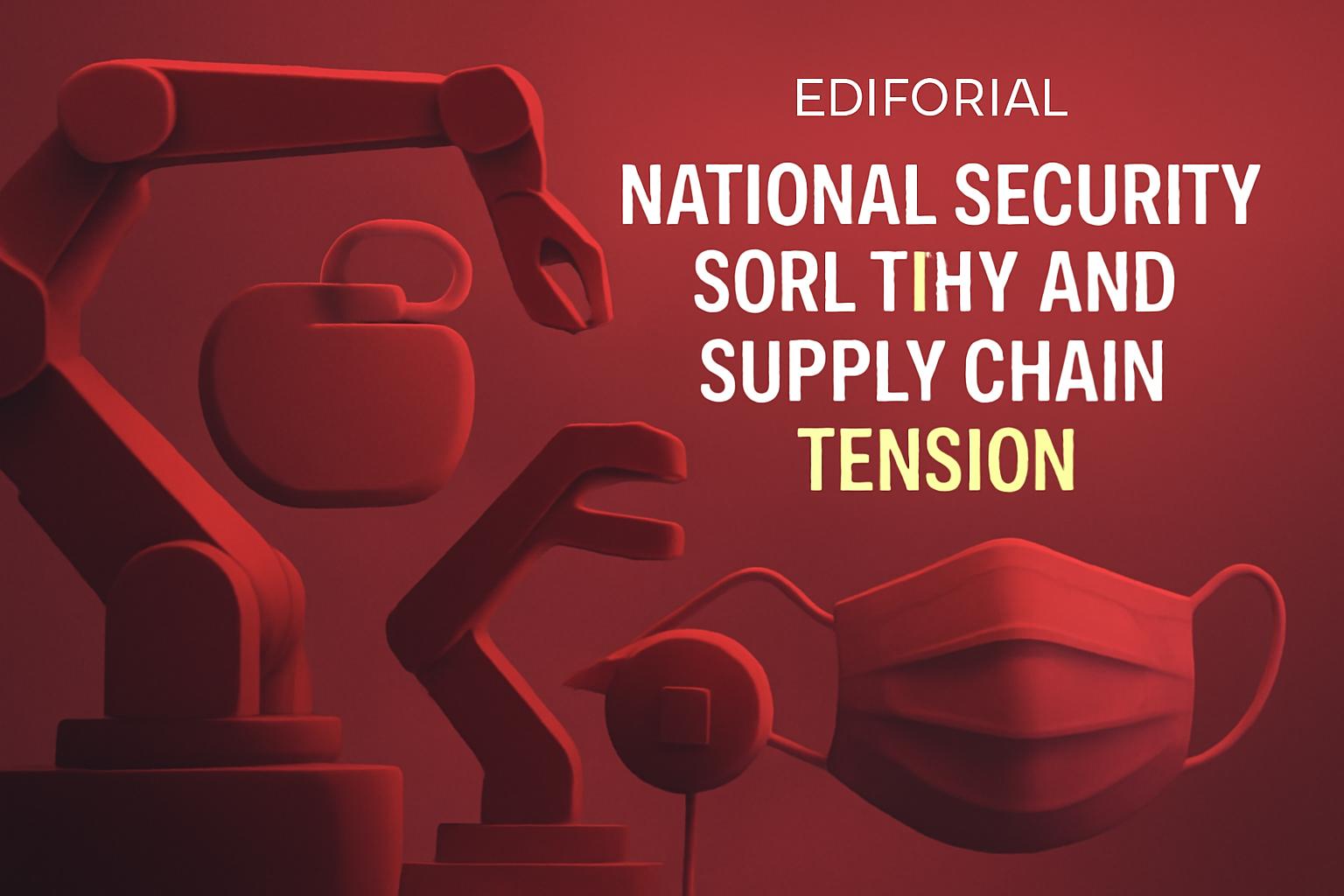The expansion of Section 232 investigations to critical sectors such as robotics, medical devices, and PPE signals a continuation of the US administration’s prioritization of national security in trade policy. While aimed at strengthening domestic manufacturing, the move carries risks of increased costs and supply chain disruptions, particularly in healthcare and automotive industries. !-- wp:paragraph -->
Contents
FinOracleAI — Market ViewFinOracleAI — Market ViewImpact on Industrial Robotics and Automotive SectorFinOracleAI — Market ViewImpact on Industrial Robotics and Automotive SectorFinOracleAI — Market ViewPotential Economic ImpactImpact on Industrial Robotics and Automotive SectorFinOracleAI — Market ViewPotential Economic ImpactImpact on Industrial Robotics and Automotive SectorFinOracleAI — Market ViewScope of the InvestigationsPotential Economic ImpactImpact on Industrial Robotics and Automotive SectorFinOracleAI — Market ViewUS Expands Section 232 Investigations to Robotics, Medical Devices, and PPEScope of the InvestigationsPotential Economic ImpactImpact on Industrial Robotics and Automotive SectorFinOracleAI — Market View
- Opportunities: Potential growth for domestic manufacturers of robotics and medical equipment; stimulus for reshoring of critical supply chains.
- Risks: Higher costs for hospitals and consumers; supply chain interruptions; retaliatory trade measures by affected countries.
FinOracleAI — Market View
The expansion of Section 232 investigations to critical sectors such as robotics, medical devices, and PPE signals a continuation of the US administration’s prioritization of national security in trade policy. While aimed at strengthening domestic manufacturing, the move carries risks of increased costs and supply chain disruptions, particularly in healthcare and automotive industries. !-- wp:paragraph -->- Opportunities: Potential growth for domestic manufacturers of robotics and medical equipment; stimulus for reshoring of critical supply chains.
- Risks: Higher costs for hospitals and consumers; supply chain interruptions; retaliatory trade measures by affected countries.
FinOracleAI — Market View
The expansion of Section 232 investigations to critical sectors such as robotics, medical devices, and PPE signals a continuation of the US administration’s prioritization of national security in trade policy. While aimed at strengthening domestic manufacturing, the move carries risks of increased costs and supply chain disruptions, particularly in healthcare and automotive industries. !-- wp:paragraph -->- Opportunities: Potential growth for domestic manufacturers of robotics and medical equipment; stimulus for reshoring of critical supply chains.
- Risks: Higher costs for hospitals and consumers; supply chain interruptions; retaliatory trade measures by affected countries.
Impact on Industrial Robotics and Automotive Sector
The automotive industry is expected to face significant challenges due to these investigations. With over 13,700 industrial robots installed in US automotive manufacturing last year—most of which are imported—new tariffs could increase production costs and disrupt supply chains. Imports from Mexico and China constitute a substantial share of US machinery purchases, underscoring the potential scale of impact. !-- wp:paragraph --> The Department of Commerce is currently soliciting feedback from companies regarding demand forecasts, domestic production capabilities, foreign subsidies, and trade practices. The outcome of these consultations will inform any subsequent tariff decisions. !-- wp:paragraph -->FinOracleAI — Market View
The expansion of Section 232 investigations to critical sectors such as robotics, medical devices, and PPE signals a continuation of the US administration’s prioritization of national security in trade policy. While aimed at strengthening domestic manufacturing, the move carries risks of increased costs and supply chain disruptions, particularly in healthcare and automotive industries. !-- wp:paragraph -->- Opportunities: Potential growth for domestic manufacturers of robotics and medical equipment; stimulus for reshoring of critical supply chains.
- Risks: Higher costs for hospitals and consumers; supply chain interruptions; retaliatory trade measures by affected countries.
“MedTech supply chain leaders are already reporting supply chain concerns, and we cannot afford to drive up the cost of health care for patients, or on the health care system,” said Whitaker. Hospital associations have echoed these concerns. Rick Pollack, CEO of the American Hospital Association, highlighted the risk of disruptions in the supply of critical devices sourced internationally, which could negatively affect patient care quality.
!-- wp:paragraph -->Impact on Industrial Robotics and Automotive Sector
The automotive industry is expected to face significant challenges due to these investigations. With over 13,700 industrial robots installed in US automotive manufacturing last year—most of which are imported—new tariffs could increase production costs and disrupt supply chains. Imports from Mexico and China constitute a substantial share of US machinery purchases, underscoring the potential scale of impact. !-- wp:paragraph --> The Department of Commerce is currently soliciting feedback from companies regarding demand forecasts, domestic production capabilities, foreign subsidies, and trade practices. The outcome of these consultations will inform any subsequent tariff decisions. !-- wp:paragraph -->FinOracleAI — Market View
The expansion of Section 232 investigations to critical sectors such as robotics, medical devices, and PPE signals a continuation of the US administration’s prioritization of national security in trade policy. While aimed at strengthening domestic manufacturing, the move carries risks of increased costs and supply chain disruptions, particularly in healthcare and automotive industries. !-- wp:paragraph -->- Opportunities: Potential growth for domestic manufacturers of robotics and medical equipment; stimulus for reshoring of critical supply chains.
- Risks: Higher costs for hospitals and consumers; supply chain interruptions; retaliatory trade measures by affected countries.
Potential Economic Impact
Industry experts warn that the imposition of tariffs on medical devices and protective gear could drive up costs for hospitals, healthcare providers, and patients. Scott Whitaker, CEO of AdvaMed, the medical technology trade group, emphasized that increased costs would likely be absorbed by taxpayer-funded programs such as Medicare, Medicaid, and the Veterans Health Administration. !-- wp:paragraph -->“MedTech supply chain leaders are already reporting supply chain concerns, and we cannot afford to drive up the cost of health care for patients, or on the health care system,” said Whitaker. Hospital associations have echoed these concerns. Rick Pollack, CEO of the American Hospital Association, highlighted the risk of disruptions in the supply of critical devices sourced internationally, which could negatively affect patient care quality.
!-- wp:paragraph -->Impact on Industrial Robotics and Automotive Sector
The automotive industry is expected to face significant challenges due to these investigations. With over 13,700 industrial robots installed in US automotive manufacturing last year—most of which are imported—new tariffs could increase production costs and disrupt supply chains. Imports from Mexico and China constitute a substantial share of US machinery purchases, underscoring the potential scale of impact. !-- wp:paragraph --> The Department of Commerce is currently soliciting feedback from companies regarding demand forecasts, domestic production capabilities, foreign subsidies, and trade practices. The outcome of these consultations will inform any subsequent tariff decisions. !-- wp:paragraph -->FinOracleAI — Market View
The expansion of Section 232 investigations to critical sectors such as robotics, medical devices, and PPE signals a continuation of the US administration’s prioritization of national security in trade policy. While aimed at strengthening domestic manufacturing, the move carries risks of increased costs and supply chain disruptions, particularly in healthcare and automotive industries. !-- wp:paragraph -->- Opportunities: Potential growth for domestic manufacturers of robotics and medical equipment; stimulus for reshoring of critical supply chains.
- Risks: Higher costs for hospitals and consumers; supply chain interruptions; retaliatory trade measures by affected countries.
Potential Economic Impact
Industry experts warn that the imposition of tariffs on medical devices and protective gear could drive up costs for hospitals, healthcare providers, and patients. Scott Whitaker, CEO of AdvaMed, the medical technology trade group, emphasized that increased costs would likely be absorbed by taxpayer-funded programs such as Medicare, Medicaid, and the Veterans Health Administration. !-- wp:paragraph -->“MedTech supply chain leaders are already reporting supply chain concerns, and we cannot afford to drive up the cost of health care for patients, or on the health care system,” said Whitaker. Hospital associations have echoed these concerns. Rick Pollack, CEO of the American Hospital Association, highlighted the risk of disruptions in the supply of critical devices sourced internationally, which could negatively affect patient care quality.
!-- wp:paragraph -->Impact on Industrial Robotics and Automotive Sector
The automotive industry is expected to face significant challenges due to these investigations. With over 13,700 industrial robots installed in US automotive manufacturing last year—most of which are imported—new tariffs could increase production costs and disrupt supply chains. Imports from Mexico and China constitute a substantial share of US machinery purchases, underscoring the potential scale of impact. !-- wp:paragraph --> The Department of Commerce is currently soliciting feedback from companies regarding demand forecasts, domestic production capabilities, foreign subsidies, and trade practices. The outcome of these consultations will inform any subsequent tariff decisions. !-- wp:paragraph -->FinOracleAI — Market View
The expansion of Section 232 investigations to critical sectors such as robotics, medical devices, and PPE signals a continuation of the US administration’s prioritization of national security in trade policy. While aimed at strengthening domestic manufacturing, the move carries risks of increased costs and supply chain disruptions, particularly in healthcare and automotive industries. !-- wp:paragraph -->- Opportunities: Potential growth for domestic manufacturers of robotics and medical equipment; stimulus for reshoring of critical supply chains.
- Risks: Higher costs for hospitals and consumers; supply chain interruptions; retaliatory trade measures by affected countries.
Scope of the Investigations
The Department of Commerce’s review encompasses a broad array of products, including surgical masks, N95 respirators, gloves, syringes, needles, prescription drugs, and critical medical equipment such as wheelchairs, hospital beds, pacemakers, insulin pumps, and heart valves. Industrial robotics and machinery imports are also under scrutiny, reflecting concerns over reliance on foreign suppliers for these strategic goods. !-- wp:paragraph --> These investigations extend the administration’s existing tariff measures, which have previously targeted automobiles, copper, steel, aluminum, pharmaceuticals, and semiconductors, as part of a broader effort to boost domestic production of goods deemed essential to national security. !-- wp:paragraph -->Potential Economic Impact
Industry experts warn that the imposition of tariffs on medical devices and protective gear could drive up costs for hospitals, healthcare providers, and patients. Scott Whitaker, CEO of AdvaMed, the medical technology trade group, emphasized that increased costs would likely be absorbed by taxpayer-funded programs such as Medicare, Medicaid, and the Veterans Health Administration. !-- wp:paragraph -->“MedTech supply chain leaders are already reporting supply chain concerns, and we cannot afford to drive up the cost of health care for patients, or on the health care system,” said Whitaker. Hospital associations have echoed these concerns. Rick Pollack, CEO of the American Hospital Association, highlighted the risk of disruptions in the supply of critical devices sourced internationally, which could negatively affect patient care quality.
!-- wp:paragraph -->Impact on Industrial Robotics and Automotive Sector
The automotive industry is expected to face significant challenges due to these investigations. With over 13,700 industrial robots installed in US automotive manufacturing last year—most of which are imported—new tariffs could increase production costs and disrupt supply chains. Imports from Mexico and China constitute a substantial share of US machinery purchases, underscoring the potential scale of impact. !-- wp:paragraph --> The Department of Commerce is currently soliciting feedback from companies regarding demand forecasts, domestic production capabilities, foreign subsidies, and trade practices. The outcome of these consultations will inform any subsequent tariff decisions. !-- wp:paragraph -->FinOracleAI — Market View
The expansion of Section 232 investigations to critical sectors such as robotics, medical devices, and PPE signals a continuation of the US administration’s prioritization of national security in trade policy. While aimed at strengthening domestic manufacturing, the move carries risks of increased costs and supply chain disruptions, particularly in healthcare and automotive industries. !-- wp:paragraph -->- Opportunities: Potential growth for domestic manufacturers of robotics and medical equipment; stimulus for reshoring of critical supply chains.
- Risks: Higher costs for hospitals and consumers; supply chain interruptions; retaliatory trade measures by affected countries.
US Expands Section 232 Investigations to Robotics, Medical Devices, and PPE
The US Department of Commerce has initiated new national security investigations under Section 232 of the Trade Expansion Act, targeting imports of robotics, industrial machinery, medical devices, and personal protective equipment (PPE). Announced on September 24, 2025, these probes aim to determine whether such imports pose risks to US national security and could justify new tariffs. !-- wp:paragraph -->Scope of the Investigations
The Department of Commerce’s review encompasses a broad array of products, including surgical masks, N95 respirators, gloves, syringes, needles, prescription drugs, and critical medical equipment such as wheelchairs, hospital beds, pacemakers, insulin pumps, and heart valves. Industrial robotics and machinery imports are also under scrutiny, reflecting concerns over reliance on foreign suppliers for these strategic goods. !-- wp:paragraph --> These investigations extend the administration’s existing tariff measures, which have previously targeted automobiles, copper, steel, aluminum, pharmaceuticals, and semiconductors, as part of a broader effort to boost domestic production of goods deemed essential to national security. !-- wp:paragraph -->Potential Economic Impact
Industry experts warn that the imposition of tariffs on medical devices and protective gear could drive up costs for hospitals, healthcare providers, and patients. Scott Whitaker, CEO of AdvaMed, the medical technology trade group, emphasized that increased costs would likely be absorbed by taxpayer-funded programs such as Medicare, Medicaid, and the Veterans Health Administration. !-- wp:paragraph -->“MedTech supply chain leaders are already reporting supply chain concerns, and we cannot afford to drive up the cost of health care for patients, or on the health care system,” said Whitaker. Hospital associations have echoed these concerns. Rick Pollack, CEO of the American Hospital Association, highlighted the risk of disruptions in the supply of critical devices sourced internationally, which could negatively affect patient care quality.
!-- wp:paragraph -->Impact on Industrial Robotics and Automotive Sector
The automotive industry is expected to face significant challenges due to these investigations. With over 13,700 industrial robots installed in US automotive manufacturing last year—most of which are imported—new tariffs could increase production costs and disrupt supply chains. Imports from Mexico and China constitute a substantial share of US machinery purchases, underscoring the potential scale of impact. !-- wp:paragraph --> The Department of Commerce is currently soliciting feedback from companies regarding demand forecasts, domestic production capabilities, foreign subsidies, and trade practices. The outcome of these consultations will inform any subsequent tariff decisions. !-- wp:paragraph -->FinOracleAI — Market View
The expansion of Section 232 investigations to critical sectors such as robotics, medical devices, and PPE signals a continuation of the US administration’s prioritization of national security in trade policy. While aimed at strengthening domestic manufacturing, the move carries risks of increased costs and supply chain disruptions, particularly in healthcare and automotive industries. !-- wp:paragraph -->- Opportunities: Potential growth for domestic manufacturers of robotics and medical equipment; stimulus for reshoring of critical supply chains.
- Risks: Higher costs for hospitals and consumers; supply chain interruptions; retaliatory trade measures by affected countries.













